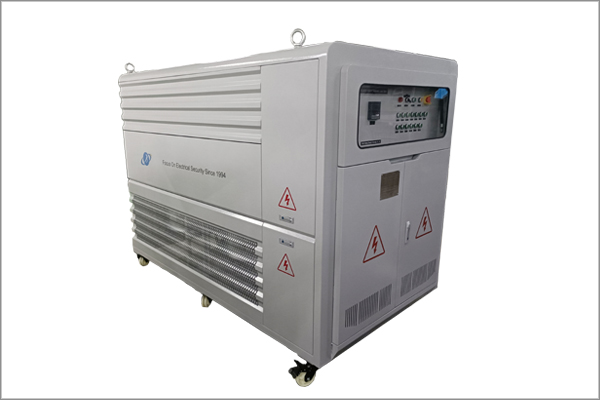The main test content of pure resistive load
Time:2024-09-27
Pure resistive load is a common type of load in the circuit, and its main feature is that the phase difference between current and voltage is zero, that is, electric energy is completely converted into heat or other forms of energy, without any form of energy storage. In order to ensure the stable and reliable performance of pure resistive loads, a series of rigorous tests are required. The following is the main test content of pure resistive load.
1000kW dummy load bank
1. Resistance test
Resistance value is one of the most critical electrical performance parameters of pure resistive loads. During the test, use a measuring device such as a multimeter or a bridge to measure the voltage and current at both ends of the load under specified conditions (such as temperature and humidity) to calculate the resistance value. During the test, ensure that the accuracy of the measuring equipment meets the requirements, and determine whether the resistance value meets the design requirements or product standards according to the test results.
2. Rated power test
The rated power is the upper limit of the power consumed by the load resistor when it runs continuously for a long time under specified conditions. During the test, the load resistance should be connected to the circuit and the power supply voltage should be gradually increased until the rated power value of the load resistance is reached. In this process, it is necessary to monitor the temperature, voltage, current and other parameters of the load resistor in real time to ensure that it runs stably at the rated power, and check whether there is overheating, damage and other phenomena.
3. Withstand pressure test
Voltage resistance test is an important means to evaluate the ability of load resistance to withstand transient overvoltage. When testing, it is necessary to apply a voltage value higher than the rated voltage to both ends of the load resistor for a certain period of time (such as a few seconds to a few minutes), and then observe whether the load resistor has a breakdown, damage and other phenomena. The purpose of voltage resistance test is to ensure that the load resistance can still work normally under harsh voltage conditions, and improve the reliability and safety of the product.
4. Stability test
Stability test is a test to evaluate whether the resistance value of the load resistance remains stable during a long period of operation. When testing, the load resistor needs to be connected to the circuit and run continuously under specified conditions for a period of time (such as a few hours to a few days), and then periodically measure its resistance value. By comparing resistance values at different time points, the stability of the load resistance can be assessed. The stable load resistance can ensure the long-term stable operation of the circuit and avoid the performance degradation caused by the resistance drift.
5. Response time test
Response time refers to the speed at which the load resistance responds to an instantaneous voltage or current change. For some circuits that require fast response, the response time of the load resistance is an important performance index. When testing, a signal generator can be used to generate a voltage or current signal that changes instantaneously and measure the response time of the load resistance. The load resistance with fast response time can quickly track the load change and improve the dynamic performance of the circuit.
6. Security test
Safety testing is to ensure that the load resistance will not cause harm to personnel and equipment during use. The test contents include fire prevention, explosion prevention, electrical safety and so on. For example, it is necessary to check whether the insulation resistance of the load resistor meets the requirements to ensure that it has good insulation performance with other circuit components; It is also necessary to check the performance of the load resistance in harsh environments such as high temperature and high humidity to ensure that it can work safely and stably in a variety of environments.
7. Standardized testing
In order to ensure that the quality and performance of the load resistance meet the requirements of the relevant standards and specifications, standardized testing is also required. The test content includes but is not limited to the measurement and evaluation of resistance value, rated power, withstand voltage, stability, response time and other parameters. At the same time, it is also necessary to check whether the identification, packaging, transportation and other aspects of the load resistance meet the requirements of the relevant standards and specifications.
In summary, the main test content of pure resistive loads covers many aspects such as resistance value, rated power, withstand voltage, stability, response time, safety and standardization. Through these tests, the performance and quality of the load resistance can be comprehensively evaluated to ensure that it can work stably and reliably in practical applications.
News Recommendation
-
 2024-09-11
2024-09-11TRIUMPH LOAD EXHIBITING AT Enlit Europe 2024 -BOOTH 7.H08
-
 2023-04-21
2023-04-21TRIUMPH LOAD EXHIBITING AT DATA CENTER WORLD GERMANY 2023-BOOTH F909
-
 2023-04-06
2023-04-06TRIUMPH LOAD EXHIBITING AT ELECTRIC POWER TECH KOREA 2023 – Booth G109
-
 2022-05-05
2022-05-05What is the role of ac load bank for power supply?
-
 2022-05-05
2022-05-05What is the role of the load bank?


